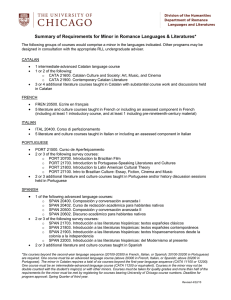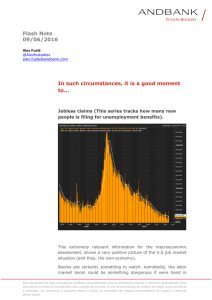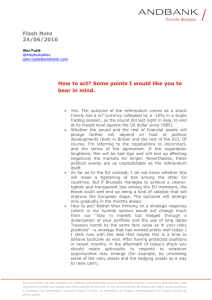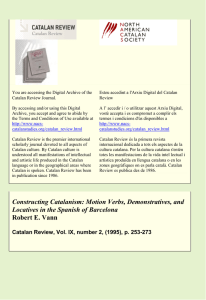Precision in historical quotations Precision in historical
Anuncio
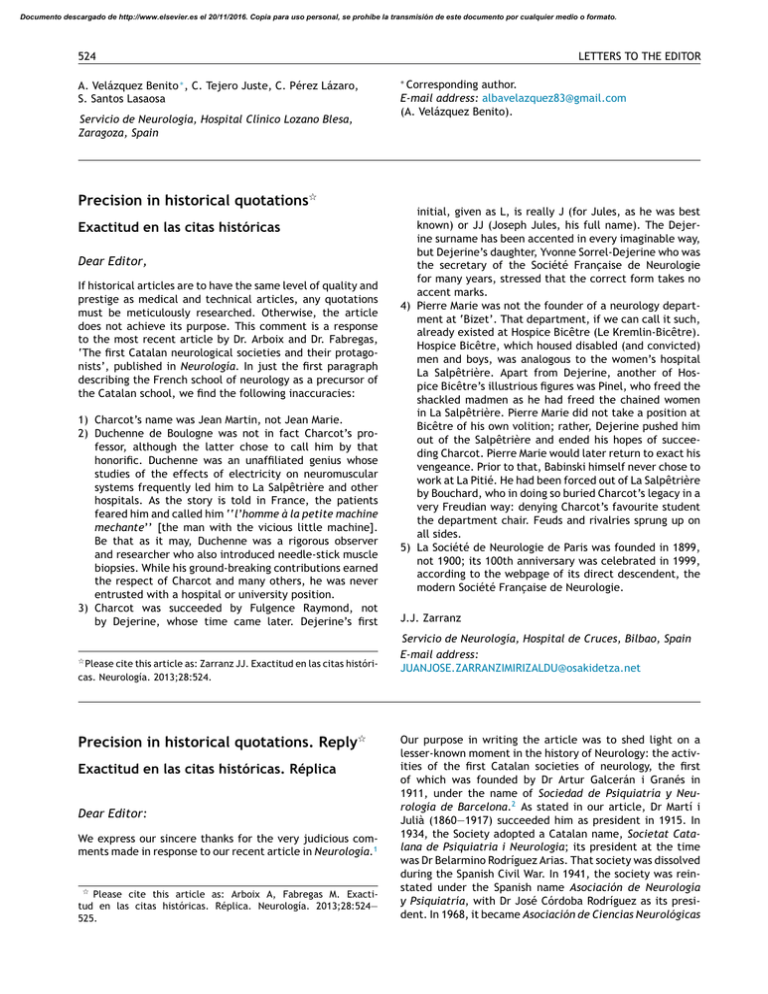
Documento descargado de http://www.elsevier.es el 20/11/2016. Copia para uso personal, se prohíbe la transmisión de este documento por cualquier medio o formato. 524 A. Velázquez Benito ∗ , C. Tejero Juste, C. Pérez Lázaro, S. Santos Lasaosa Servicio de Neurología, Hospital Clínico Lozano Blesa, Zaragoza, Spain Precision in historical quotations夽 Exactitud en las citas históricas Dear Editor, If historical articles are to have the same level of quality and prestige as medical and technical articles, any quotations must be meticulously researched. Otherwise, the article does not achieve its purpose. This comment is a response to the most recent article by Dr. Arboix and Dr. Fabregas, ‘The first Catalan neurological societies and their protagonists’, published in Neurología. In just the first paragraph describing the French school of neurology as a precursor of the Catalan school, we find the following inaccuracies: 1) Charcot’s name was Jean Martin, not Jean Marie. 2) Duchenne de Boulogne was not in fact Charcot’s professor, although the latter chose to call him by that honorific. Duchenne was an unaffiliated genius whose studies of the effects of electricity on neuromuscular systems frequently led him to La Salpêtrière and other hospitals. As the story is told in France, the patients feared him and called him ‘‘l’homme à la petite machine mechante’’ [the man with the vicious little machine]. Be that as it may, Duchenne was a rigorous observer and researcher who also introduced needle-stick muscle biopsies. While his ground-breaking contributions earned the respect of Charcot and many others, he was never entrusted with a hospital or university position. 3) Charcot was succeeded by Fulgence Raymond, not by Dejerine, whose time came later. Dejerine’s first 夽 Please cite this article as: Zarranz JJ. Exactitud en las citas históri- cas. Neurología. 2013;28:524. Precision in historical quotations. Reply夽 Exactitud en las citas históricas. Réplica Dear Editor: We express our sincere thanks for the very judicious comments made in response to our recent article in Neurología.1 夽 Please cite this article as: Arboix A, Fabregas M. Exactitud en las citas históricas. Réplica. Neurología. 2013;28:524— 525. LETTERS TO THE EDITOR ∗ Corresponding author. E-mail address: albavelazquez83@gmail.com (A. Velázquez Benito). initial, given as L, is really J (for Jules, as he was best known) or JJ (Joseph Jules, his full name). The Dejerine surname has been accented in every imaginable way, but Dejerine’s daughter, Yvonne Sorrel-Dejerine who was the secretary of the Société Française de Neurologie for many years, stressed that the correct form takes no accent marks. 4) Pierre Marie was not the founder of a neurology department at ‘Bizet’. That department, if we can call it such, already existed at Hospice Bicêtre (Le Kremlin-Bicêtre). Hospice Bicêtre, which housed disabled (and convicted) men and boys, was analogous to the women’s hospital La Salpêtrière. Apart from Dejerine, another of Hospice Bicêtre’s illustrious figures was Pinel, who freed the shackled madmen as he had freed the chained women in La Salpêtrière. Pierre Marie did not take a position at Bicêtre of his own volition; rather, Dejerine pushed him out of the Salpêtrière and ended his hopes of succeeding Charcot. Pierre Marie would later return to exact his vengeance. Prior to that, Babinski himself never chose to work at La Pitié. He had been forced out of La Salpêtrière by Bouchard, who in doing so buried Charcot’s legacy in a very Freudian way: denying Charcot’s favourite student the department chair. Feuds and rivalries sprung up on all sides. 5) La Société de Neurologie de Paris was founded in 1899, not 1900; its 100th anniversary was celebrated in 1999, according to the webpage of its direct descendent, the modern Société Française de Neurologie. J.J. Zarranz Servicio de Neurología, Hospital de Cruces, Bilbao, Spain E-mail address: JUANJOSE.ZARRANZIMIRIZALDU@osakidetza.net Our purpose in writing the article was to shed light on a lesser-known moment in the history of Neurology: the activities of the first Catalan societies of neurology, the first of which was founded by Dr Artur Galcerán i Granés in 1911, under the name of Sociedad de Psiquiatría y Neurología de Barcelona.2 As stated in our article, Dr Martí i Julià (1860—1917) succeeded him as president in 1915. In 1934, the Society adopted a Catalan name, Societat Catalana de Psiquiatria i Neurologia; its president at the time was Dr Belarmino Rodríguez Arias. That society was dissolved during the Spanish Civil War. In 1941, the society was reinstated under the Spanish name Asociación de Neurología y Psiquiatría, with Dr José Córdoba Rodríguez as its president. In 1968, it became Asociación de Ciencias Neurológicas Documento descargado de http://www.elsevier.es el 20/11/2016. Copia para uso personal, se prohíbe la transmisión de este documento por cualquier medio o formato. LETTERS TO THE EDITOR under the presidency of Dr Lluís Barraquer Bordas. It was not until 1973 that it adopted its current Catalan name: Societat Catalana de Neurologia. Its first president was Dr Agustí Codina Puiggròs. As might be expected due to the proximity to France, the first Catalan neurological societies were influenced considerably by the French school of neurology.1—3 We believe that adding precise details to the scarce historical record of the early days of Spanish neurology is an important endeavour. On that note, we close with the very true and relevant words of the 17th century historian Cabrera de Córdoba: ‘‘He who closely examines the history of ancient times, and is mindful of its lessons, will gain insight for future events; for the ways of the world are unchanging.’’ 525 2. Arboix A, Fabregas MG. La faceta neurológica del Dr. Artur Galcerán i Granés (1850—1919). Neurologia. 2011;26:239— 43. 3. Arboix A, Gironell A, de Fabregues O, Font MA, Izquierdo J, Krupinski J, et al. Història de la neurologia catalana. Societat Catalana de Neurologia. Barcelona: CPM Asociados SL; 2011. A. Arboix ∗ , M.G. Fabregas Unidad de Enfermedades Vasculares Cerebrales, Servicio de Neurología, Capio-Hospital Universitari del Sagrat Cor, Universitat de Barcelona, Barcelona, Spain Corresponding author. E-mail address: aarboix@hscor.com (A. Arboix). ∗ References 1. Arboix A, Fabregas MG. Las primeras sociedades neurológicas catalanas y sus protagonistas. Neurologia. 2012;27:112—8.

